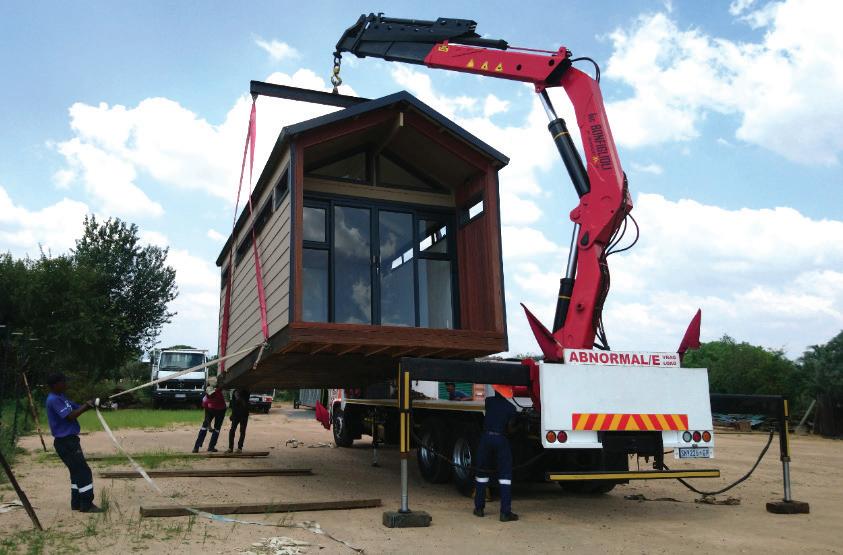
4 minute read
Forestry and paper
Sonae Arauco has expanded its White River factory.
Timber frame house. Image: Eco Log Homes
Advertisement
The White River plant of Sonae Arauco now offers more decorative solutions because of the installation in 2019 of a Dieffenbacher melamine press. The company’s aim is to make the site a uniquely integrated facility.
Among the new offerings as a result of the R200-million expansion are a woodgrain named for and inspired by the Chobe River and Grigio, a “marbled fantasy décor”. The company produces particleboard and fibreboard, melamine-faced boards and finishes. The invitation to the launch of the factory extension claimed that the factory is the “most efficient in Africa”. The company has another plant at Panbult between Ermelo and Mkhondo (Piet Retief).
Sawmilling South Africa (SSA) and the Institute for Timber Construction South Africa (ITC-SA) made an offer during the Covid-19 lockdown to share with the South African government their skills and expertise. Sawmilling South Africa is an industry association which represents the majority of sawmillers in South Africa. By building alternative housing (with wood), it was felt that this could contribute to thinning out densely populated informal settlements to slow the spread of the virus.
Mpumalanga has the ideal climate and topography for forests. Sabie and Graskop represent the hub of the industry, but commercial forests are also found to the east and south along the Swaziland border. About 11% of the land mass is forested, with 4% of that being natural forest. The province is the national leader in total hectares under forest (514 000ha) and in export earnings.
Forestry accounts for about 8% of Mpumalanga’s gross
Sector Insight An Agriculture and Forestry Technology Park is planned.
domestic product. The sector comprises logging, saw-milling, wood product and pulp and paper manufacture. Pulp and paper are the main exports, along with sawn lumber, wood chips and wattle extract. Most sawn timber in South Africa is used in the construction sector.
The Provincial Government of Mpumalanga plans to develop an Agriculture and Forestry Technology Park. The Mpumalanga Economic Growth and Development Path (MEGDP) intends to expand the industrial base of the provincial economy with a focus on beneficiation, agri-processing and the development of value chains.
Companies
Sustainability is the modern watchword but finding a way to use resources for people is also popular. The MTO Group, which has 39 900ha of plantation under management in the Lowveld, has teamed up with mountainbike enthusiasts of White River and Nelspruit to develop a set of trails through the hilly landscape of the area.
One of the biggest operations in the forestry and paper sector in Mpumalanga is Sappi’s Ngodwana Mill. The mill produces 330 000 tons of paper pulp for its own consumption, 250 000 tons of dissolving wood pulp (DWP) and 380 000 tons of paper (newsprint and kraft linerboard used for packaging) annually. Exports account for 70% of the mill’s product.
Ongoing investment at Ngodwana Mill will contribute R13-billion to the provincial economy over 20 years. Sappi’s other large facility in the province, the Lomati Sawmill in Barberton, produces kiln-dried Southern African pine lumber from sawlogs supplied by Sappi Forests.
The mill generates its own energy through co-generation (steam and electricity from renewable and other sources). Sappi has recently built a sugar-extraction demonstration plant at Ngodwana. Findings from the experiment will help to improve the process of extracting bio-renewable chemicals. Sappi is partnering with Valmet, a Finnish company.
Other forestry companies are looking into energy generation, including AFCOL. Mpumalanga has 40% of South Africa’s forestry resources. This fact presents an opportunity to exploit the sector’s byproducts in the biomass-to-energy field.
The Zebra Pellets plant in Sabie is to be converted by national utility Eskom into a torrified pellet plant. The wood will be provided to the plant (owned by the Industrial Development Corporation) and then heated without the use of oxygen (torrified) which creates a coal-like product without the carbon.
York Timbers owns and operates five processing plants, including the including the largest sawmill and plywood plants in South Africa and it has 60 470 planted hectares. The company is considering investing in biomass energy generation. The Industrial Development Corporation (IDC) has a stake in York Timbers and a 42.6% share in Hans Merensky Holdings, a company with timber and processing interests in three provinces. Merensky is responsible for 20% of South Africa’s sawn pine lumber.
The Mondi Group has extensive forestry holdings in the province and has been working on introducing a higher degree of mechanisation in its operations. Mondi has also instituted an ecosystem management plan throughout its forestry operations with the intention of better managing the impact its work has on the environment.
Although local demand is dwindling, the export market for pulp and paper is strong. Pulp production figures have been on the rise for several years and companies like Mondi are increasingly focusing on pulp export because of better margins.
PG Bison has a board plant in Piet Retief. Komatiland Forests, a 100% owned subsidiary of state company SAFCOL, has big plantations in several districts. TWK is a R6-billion agricultural company with its headquarters in Mkhondo. ■
Online Resources
Forestry South Africa: www.forestry.co.za Institute for Timber Construction South Africa: www. itc-sa.org Sawmilling South Africa: www.timber.co.za Technical Association of the Pulp and Paper Industry of South Africa: www.tappi.org








